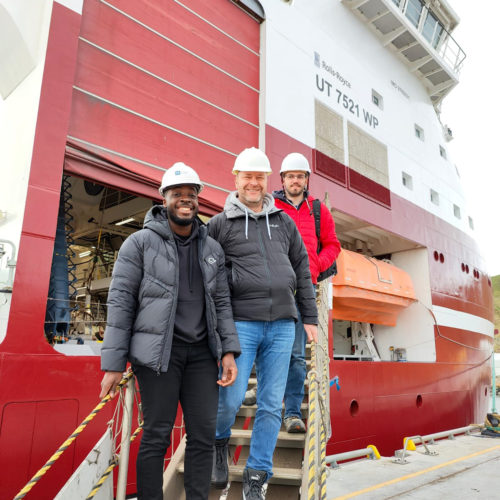
PFOWF have recently completed a geotechnical survey for the site – providing essential information to inform project design.
We spoke to Miracle Yaw Antobre-Seinuah, Project & Engineering Management Graduate who took part in the offshore operations for the campaign.
What was the purpose of the trip?
Our main objective was to gather engineering data from across the site and intact soil and rock samples from below the seafloor.
This additional data combines with our existing geophysical and geotechnical data from previous campaigns. It deepens our understanding of the Pentland site, improves our ground model, derives engineering parameters, and facilitates detailed design and installation studies for the turbine foundations.
The campaign lasted roughly one month. It began with a mobilisation from Scrabster Harbour. The survey activities took place at various predetermined locations within the Pentland wind farm area and cable corridor.
Why does the project need geotechnical data?
We need to gather vital data regarding soil and rock qualities and seafloor stability, so a geotechnical campaign allows us to do this. We employ a combination of sampling boreholes, cone penetration tests, and in-situ testing to gather valuable information about the lithology (physical rock characteristics) and properties of the site.
This data plays a critical role in designing effective offshore foundations, including anchoring systems, by considering factors such as the soil strength and its response to lateral forces and cyclic loading. It also supports us to assess and mitigate risks associated with any slope instability, and potential seabed settlements.
Finally, the campaign assists in construction planning by identifying potential challenges related to the installation of subsea infrastructure.
Who was on the trip?
The campaign involved 28 people from Copenhagen Offshore Partners (COP) and Geoquip Marine, our selected contractor for the campaign. My position was as a client representative, one of the main points of contact for COP throughout the survey process.
As part of this responsibility, the client representatives closely monitored drilling and coring activities, took charge of tracking the survey's budgets and coordinated communication and logistics activities between COP and the survey team. Importantly, we also ensured the survey adhered to COP's specified objectives and safety standards.
What was the trip highlight for you?
Having the chance to be on-site at the wind farm was truly an extraordinary experience for me. It provided a profound understanding of the environment in which the turbines would be installed. Envisioning it is one thing, but being physically present offered a different perspective, particularly regarding the impact of weather conditions. It instilled a sense of gratitude, knowing that our efforts directly contribute to a positive outcome for the environment.
Another experience which had an impact on me was the opportunity to thoroughly explore Thurso. Spending time at the visitor centre and delving into the history of the former Dounreay Nuclear Site proved to be a captivating experience. It was intriguing to comprehend the profound impact it had on the local economy.
This realisation further highlighted the potential for projects like Pentland to make a positive impact on the community by providing sustainable energy solutions and job opportunities.
What are the next steps for the project following this survey?
Following the completion of the geotechnical survey, the next critical phase in the process will be onshore laboratory testing. This phase allows us to go further into the acquired samples and gather critical information about the site's characteristics.
This investigation will contribute to a complete report that will serve as a valuable resource, providing a deeper understanding of the nature of the site. We can make educated judgements about the project's design and implementation by leveraging the facts and insights from the report and ensuring our activities correspond with the site's specific requirements.
Are there any learnings you’ll apply to your work going forward?
Being involved in this survey has truly heightened my appreciation for the importance of site investigation work. As I continue to contribute to the site investigation package for Pentland, I can confidently say that this experience has greatly improved my understanding of these processes during the Front-End Engineering Design phase for offshore wind farms. This knowledge will be invaluable in making informed design decisions.




